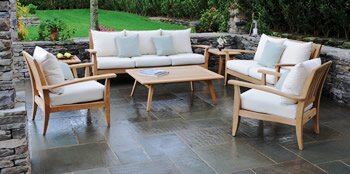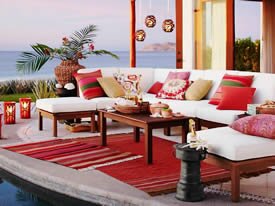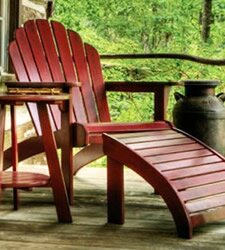 Wood outdoor furniture offers an earthy and natural addition to a backyard, deck, porch, patio, or garden. Wood outdoor furniture is available in styles ranging from traditional to contemporary and blends well with stone, brick or concrete. With care, wood furniture will continue to perform well for years to come.
Wood outdoor furniture offers an earthy and natural addition to a backyard, deck, porch, patio, or garden. Wood outdoor furniture is available in styles ranging from traditional to contemporary and blends well with stone, brick or concrete. With care, wood furniture will continue to perform well for years to come.
The types of wood used for outdoor furniture is as varied as the styles, but understanding the characteristics of the wood and how it weathers is very important in determining what best suits your needs. Many people assume that since a tree sits outside in the elements, all furniture constructed of wood will survive indefinitely in an outdoor area. However, remember that the bark on a tree helps protect the wood inside and a living tree is able to get moisture to keep it from drying out.
 Tectona Grandis is known as one of the strongest and most durable woods available. This makes teak the ideal candidate when selecting a wood for outdoor furniture. If its strength and durability aren’t enough to entice you, then perhaps the fact that teak patio furniture requires virtually no maintenance will peak your interest!
Tectona Grandis is known as one of the strongest and most durable woods available. This makes teak the ideal candidate when selecting a wood for outdoor furniture. If its strength and durability aren’t enough to entice you, then perhaps the fact that teak patio furniture requires virtually no maintenance will peak your interest!
With the natural teak oil that is produced from within the wood itself, teak will continually recondition naturally, making it an excellent weather and insect resistant wood. Thanks to this natural oil, teak is also highly resistant to rot and fungal decay. If you do not mind the natural graying that occurs from exposure to the sun, teak is capable of weathering for 50 years or more with minimal maintenance.
 Tectona Grandis trees are grown in Indonesia on controlled plantations to guarantee protection of the local ecology and help contribute to the decline of random logging that deforests the earth’s rainforests. This process also contributes to the cost of growing and harvesting teak. Generally manufacturers who choose to construct their furniture with this most durable and expensive wood will use premium construction and finishing techniques like mortise and tenon joinery and multiple wet sandings for a smooth, even finish.
Tectona Grandis trees are grown in Indonesia on controlled plantations to guarantee protection of the local ecology and help contribute to the decline of random logging that deforests the earth’s rainforests. This process also contributes to the cost of growing and harvesting teak. Generally manufacturers who choose to construct their furniture with this most durable and expensive wood will use premium construction and finishing techniques like mortise and tenon joinery and multiple wet sandings for a smooth, even finish.
Be careful when selecting teak furniture. There are many trees that are described as teak or teak-like (often from South America or Africa) but are not Tectona Grandis. Outdoor furniture constructed of these woods will cost less and will last a fraction of the time. Hint: If someone shows you “teak” and it is painted, or they say that it can be painted, it is not true teak. The natural oil in teak does not allow for a paint finish to adhere to the wood.
 Mahogany is a moderately durable hardwood that will also weather to a silver grey color when exposed to the elements. Although mahogany outdoor furniture will not last as long as teak, it does have a benefit that teak does not—it does not contain as much natural oil and can be painted.
Mahogany is a moderately durable hardwood that will also weather to a silver grey color when exposed to the elements. Although mahogany outdoor furniture will not last as long as teak, it does have a benefit that teak does not—it does not contain as much natural oil and can be painted.
Once again, be cautious when buying outdoor furniture made from mahogany. There are several timbers that are referred to under the generic heading of “mahogany” and are forested from non-sustained forests.
 Brazilian Cherry is a dense wood that grows in South America. A popular type of wood due to its density and natural weather resistance, it is very sturdy and heavy and will give many years of use in an outdoor environment.
Brazilian Cherry is a dense wood that grows in South America. A popular type of wood due to its density and natural weather resistance, it is very sturdy and heavy and will give many years of use in an outdoor environment.
Brazilian Cherry is naturally a deep red color and has a strong grain pattern which, if left unfinished or oiled, will turn silver gray over time. Unlike teak, Brazilian cherry can be painted giving it an extra layer of protection from the sun and moisture.
 A heavy, dense wood that is native to western Australia, jarrah is a member of the Eucalyptus (Gum) family of trees. It is red in color but it, too, will weather to a silver grey when exposed to the sun and moisture. Outdoor furniture constructed of jarrah wood is very heavy, durable and typically of good quality but, again, will not last as long as true teak.
A heavy, dense wood that is native to western Australia, jarrah is a member of the Eucalyptus (Gum) family of trees. It is red in color but it, too, will weather to a silver grey when exposed to the sun and moisture. Outdoor furniture constructed of jarrah wood is very heavy, durable and typically of good quality but, again, will not last as long as true teak.
 Proper maintenance of your wood furniture will provide a long life over many years in a variety of weather environments. Maintaining outdoor wood furniture requires little effort if the natural graying is desired. You will notice, over time, that your outdoor wood furniture becomes rougher and more grainy in appearance. This is natural and should not affect the stability of the product. Teak, however, will not splinter, split or crack.
Proper maintenance of your wood furniture will provide a long life over many years in a variety of weather environments. Maintaining outdoor wood furniture requires little effort if the natural graying is desired. You will notice, over time, that your outdoor wood furniture becomes rougher and more grainy in appearance. This is natural and should not affect the stability of the product. Teak, however, will not splinter, split or crack.
If the original color of the wood is preferred, oils and sealers are available. Note that using the proper products will result in better results. Many oils that are used for indoor furniture (including teak) have detrimental effects when used outside. They often become sticky and gummy when exposed to the sun, resulting in a messy goo that will stain clothing and often attract bugs.
Outdoor wood furniture should be cleaned once a year. Mix one tablespoon of bleach, five tablespoons of a gentle dishwashing liquid, and a gallon of water, and softly rub the surface of your wood furniture with a soft bristle brush. Wash the solution from the furniture, and allow it to dry completely in the sun. Repainting or restaining wood furniture could be indicated at this time to cover and protect any worn or damaged areas.
Have questions on the essentials of outdoor furniture and accessories? Just ask we'd be glad to help.
 Wood outdoor furniture offers an earthy and natural addition to a backyard, deck, porch, patio, or garden. Wood outdoor furniture is available in styles ranging from traditional to contemporary and blends well with stone, brick or concrete. With care, wood furniture will continue to perform well for years to come.
Wood outdoor furniture offers an earthy and natural addition to a backyard, deck, porch, patio, or garden. Wood outdoor furniture is available in styles ranging from traditional to contemporary and blends well with stone, brick or concrete. With care, wood furniture will continue to perform well for years to come. What To Look For
What To Look For Caring for Wood Furniture
Caring for Wood Furniture




 Tectona Grandis is known as one of the strongest and most durable woods available. This makes teak the ideal candidate when selecting a wood for outdoor furniture. If its strength and durability aren’t enough to entice you, then perhaps the fact that teak patio furniture requires virtually no maintenance will peak your interest!
Tectona Grandis is known as one of the strongest and most durable woods available. This makes teak the ideal candidate when selecting a wood for outdoor furniture. If its strength and durability aren’t enough to entice you, then perhaps the fact that teak patio furniture requires virtually no maintenance will peak your interest! Tectona Grandis trees are grown in Indonesia on controlled plantations to guarantee protection of the local ecology and help contribute to the decline of random logging that deforests the earth’s rainforests. This process also contributes to the cost of growing and harvesting teak. Generally manufacturers who choose to construct their furniture with this most durable and expensive wood will use premium construction and finishing techniques like mortise and tenon joinery and multiple wet sandings for a smooth, even finish.
Tectona Grandis trees are grown in Indonesia on controlled plantations to guarantee protection of the local ecology and help contribute to the decline of random logging that deforests the earth’s rainforests. This process also contributes to the cost of growing and harvesting teak. Generally manufacturers who choose to construct their furniture with this most durable and expensive wood will use premium construction and finishing techniques like mortise and tenon joinery and multiple wet sandings for a smooth, even finish. Mahogany is a moderately durable hardwood that will also weather to a silver grey color when exposed to the elements. Although mahogany outdoor furniture will not last as long as teak, it does have a benefit that teak does not—it does not contain as much natural oil and can be painted.
Mahogany is a moderately durable hardwood that will also weather to a silver grey color when exposed to the elements. Although mahogany outdoor furniture will not last as long as teak, it does have a benefit that teak does not—it does not contain as much natural oil and can be painted. Brazilian Cherry is a dense wood that grows in South America. A popular type of wood due to its density and natural weather resistance, it is very sturdy and heavy and will give many years of use in an outdoor environment.
Brazilian Cherry is a dense wood that grows in South America. A popular type of wood due to its density and natural weather resistance, it is very sturdy and heavy and will give many years of use in an outdoor environment. A heavy, dense wood that is native to western Australia, jarrah is a member of the Eucalyptus (Gum) family of trees. It is red in color but it, too, will weather to a silver grey when exposed to the sun and moisture. Outdoor furniture constructed of jarrah wood is very heavy, durable and typically of good quality but, again, will not last as long as true teak.
A heavy, dense wood that is native to western Australia, jarrah is a member of the Eucalyptus (Gum) family of trees. It is red in color but it, too, will weather to a silver grey when exposed to the sun and moisture. Outdoor furniture constructed of jarrah wood is very heavy, durable and typically of good quality but, again, will not last as long as true teak. Proper maintenance of your wood furniture will provide a long life over many years in a variety of weather environments. Maintaining outdoor wood furniture requires little effort if the natural graying is desired. You will notice, over time, that your outdoor wood furniture becomes rougher and more grainy in appearance. This is natural and should not affect the stability of the product. Teak, however, will not splinter, split or crack.
Proper maintenance of your wood furniture will provide a long life over many years in a variety of weather environments. Maintaining outdoor wood furniture requires little effort if the natural graying is desired. You will notice, over time, that your outdoor wood furniture becomes rougher and more grainy in appearance. This is natural and should not affect the stability of the product. Teak, however, will not splinter, split or crack.